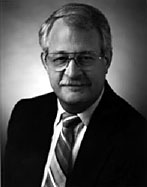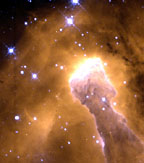|
Wesley T. Huntress, Jr.
–
astrophysicist & astronautics specialist
|

|
"
Find out what it is that you love doing. Make that your occupation, and you will be happy and creative for the rest of your life.
" |

|
| |
|
|
|
| |
How were you motivated to choose your particular field? |
| |
I had to know what it was like out there! What is it like on the Moon, on Mars, on Venus, on all those planets and moons? Are there planets around other stars? Is there other life out there? I asked myself those questions as far back as I can remember first looking at the sky. That curiosity led me inevitably to where I am today, even if by a somewhat circuitous route, always pulling me in the direction of space exploration and science.
Why did I ask those questions? I can't give a precise answer. As a child I could touch and examine reality in my earthly environment, but I couldn't reach the reality of those things in the sky. I couldn't roll them around in my hand and examine them, so I wondered how I could find out what they were. From the age of about six, my grandfather took me to all the museums in Washington, D.C., so I could learn as much as I could about my world and its inhabitants. He took me to planetariums so I could learn about the sky and what was out there. And he took me to the airport so I could see what man had done to create vehicles to explore this world, and he took me on a plane ride to get as close to "out there" as could be done in the late 1940s and early 1950s. I haunted Washington National Airport on many weekends.
I could follow these leads in my mind because of a family attitude to open the world to a child and to let the child define the opportunity space to explore. Three events prior to college cemented my future direction. My first grade teacher read a book to the class titled Dr. Doolittle Goes to the Moon. It was a fantasy, but it led me to try and understand how one could really do that and what it would really be like on the Moon. The second was a chemistry set I got when I was eleven. I was fascinated by the magic you could do with chemistry. I experimented with rocket fuels in my basement lab. And finally, there was Sputnik early in my sophomore year of High School. That was it! It really was going to be possible to go into space. I built small, homemade rockets fired on abandoned railroad tracks, and a large rocket under supervision of the U.S. Army when I was a senior. I went to college to become a scientist so I could learn how the universe worked, and I went to JPL after college to become part of the enterprise that would explore it.
|
|

|
| |
|
|
|
| |
What can you share about your creative process? |
| |

|
|
Works of enduring value spring from both environment and individual. All humans feel a need to be creative. This will flourish if there is an environment that allows the creative instinct to be expressed. Parents must create an environment that allows a child to discover that which interests them most, and then encourage that interest.
To be a creative individual, you must be able to do what you like doing. If you like what you are doing, the spark of creativity will quite naturally occur in the pursuit of that activity. Find out what it is that you love doing. Make that your occupation, and you will be happy and creative for the rest of your life.
Inspired and visionary works do not arise spontaneously; they require work. Lasting works of value are created by digging deep into a subject and by searching broadly, in order to form a new synthesis. Working hard at something you enjoy doing is immensely satisfying. Out of that continuing satisfaction and hard work will ultimately arise creative, new and inspired works.
|
|
| |
|
|
|
| |
What ideas do you have for a future human community on Mars?
|
| |
I don't think we will go to Mars immediately after the Space Station is built. It is too big a step. It will also prove too expensive and risky. But we will go Mars, and it should remain the ultimate goal for human space flight in the next century. We will get there in a more systematic and natural way without a large, immediate infusion of money into the space program. We will get to Mars by proceeding first through a set of ever more challenging destinations. After the Space Station, we will start by constructing and servicing huge telescopes in the Earth–Sun Lagrangian points to image planets around other stars. Next we will progress to a surface outpost on the Moon, and then to exploration of the surface of Near Earth Asteroids and the two small moons of Mars. Finally, we will establish an outpost on Mars and begin the process of colonizing the planet.
Humans will be preceded by robotic missions to each of these destinations. Robotic colonies will be set up on the Moon, on an asteroid, on Phobos and finally on Mars, built in the same image as human colonies and able to subsist, work, build, repair and explore almost autonomously. They will conduct their surface exploration on only the very simplest of requests from humans on Earth: "Find and analyze a rock of this type", or "Determine the location of the nearest subsurface aquifer." Everyone will be able to follow the lives and adventures of these robots through real-time video and audio transmitted to Earth by the Mars communication and navigation satellite network.
These robotic colonies will be the first "cities" on the planet, and they will prepare the ground for human occupation. When humans arrive, they will simply "plug–in" to the already established working colony and will begin work as partners with the robots. The robots will provide an extension of the senses for the humans living and working on Mars.
This partnership between intelligent robotic machines and human beings will be the hallmark of humanity's escape from Earth's cradle and the spread of homo sapiens into space.
|
|

|
|




